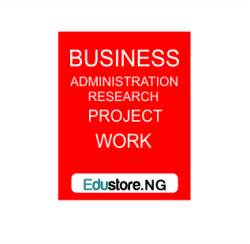The Problem Of Human Resources Management On Organizational Performance (A Case Study Of Dangote Flour Mill)
Abstract
This study was on the problem of human resource management on organizational performance. (a case study of Dangote flour mill). The total population for the study is 200 staff Dangote flour mill, Lagos state. The researcher used questionnaires as the instrument for the data collection. Descriptive Survey research design was adopted for this study. A total of 133 respondents made human resource managers, accountants, production managers and marketers were used for the study. The data collected were presented in tables and analyzed using simple percentages and frequencies.
Chapter one
Introduction
1.1Background of the study
The management of people within the organisation has become an increasingly recognized important focus for researchers and practitioner over the past 20 years. Organisations are becoming more aware of important role human resource play in the success of their organisations to achieve financial performance. As a result, organisations are becoming more employee-centric by focusing on enhancing employees’ engagement and organisational commitment
It is important for organisation to adopt human resources management (HRM) system that optimizes workforce as it enables organisation to achieve competitive advantage in today’s global market economy that provides wider access to technology, finance and other resources. Pfeffer (1994) stated that firms have increasingly recognized the potential for their people to be a source of competitive advantage. Creating competitive advantage through people requires careful attention to the practices that best leverage these assets. According to Nishii, (2008) scholars generally agree that appropriately designed, Human resources management practices can enhance organizational performance. Related theories suggesting and supporting assumption holds that the practices of Human Resources Management influences employees attitudes and behaviours.
Human Resource Management is an invisible asset in an organisation. It creates value when embedded in the operational system that enhances organisational performance and ability to deal with turbulent environment. Effective HRM assists in developing human resources into high quality and efficient workforce thus enabling the organisation to obtain a competitive advantage through their people. In contrast, inefficient workforce can increase labour cost and decrease organisation productivity. However, in order to remain competitive, grow and diversify, an organisation must ensure that its employees are qualified, placed in appropriate position, properly trained, managed effectively and committed to the firm’s success. The goal of HRM is to maximize employees contribution in order to achieve optimal productivity and effectiveness while simultaneously attaining individual objective (such as having a challenging job) and obtaining recognition) and societal objectives (such as legal compliance and demonstrating social responsibility).
Human resource dimensions or practices (training, recruitment, reward system performance appraisal etc) have considerable impact on the performance of organizations and these contribute to the affirmative link between human resource management and organizational performance (Osman, 2012).
Training is a flexible way to develop an employee as it consists of both formal and informal ways to enhance the effectiveness and efficiency of employees (Ellstrom, 2011). Job security increases employees’ honesty, keeps employees committed to the organization and provides security to valuable information as well (Raji and Jackson, 2011). Reward system is imposed on organization to evaluate reward and organization reward employees on the basis to get value by elaborating what they have spent and what they have got (Armstrong, 2011). Employee performance can be evaluated by the evaluation of task and reward system. Employee performance is one that is affected by the knowledge transfer that helps employee to develop their understanding of networking as well as focusing on the organizational performance.
Organizational performance is related to organizational justice which allows employees to get committed to task assigned to him or her. HRM dimensions greatly influences the employees attitude which in turn affects employees’ performance. If HRM system works effectively, then increase in the organizational performance will be seen (Snape and Redman, 2010). Competitive advantage is viewed as a source of competitive advantage is a must for any organization and employees are always viewed as source of competitive advantage for any organization (Barney, 1991; Pfeffer, 1994). So, human resource management must be made in such a way that can utilize employees in the best possible way to increase performance of organizations.
1.2 STATEMENT OF THE PROBLEM
Research problem is an intellectual stimulus calling for an answer in the form of scientific inquiry.
From experience over the years, with the role of human resource management in the achievement of organizational goal in Nigeria compared to other organizations of the world. It has been observed that human resource management in Nigeria have not performed well to support the efficiency and growth of the nation.
Any management that is keen on training its personnel is usually faced with the problem of cost/benefit analysis. It is very easy to work cost but it is difficult to put value on the asset. It is therefore pertinent to list the problems associated with training human resource in the organization.
It has been observed that the problem facing business and increasingly number of workers are being faced with poor condition of service including remuneration. Furthermore, the foreign exchange problem has added a new dimension to the range of problem facing business organization. The overall effect of the problem is that most business organization can no longer afford to offer the employees good remuneration and adequate compensation for their labour. This is a situation that brought about ineffectiveness of human resource in the achievement of organizational goals.
Presently, Nigeria economy is experiencing some economic difficulties which have resulted in retirements, retrenchments, lay-offs, mergers and acquisitions and dismissal of employees.
Furthermore, prominent among the reasons why organizations perform poorly in most organization in Nigeria is the problem of fund. Thus, this is the reason for the introduction of two schemes and programmes by the federal Government through the CBN which are geared towards improving the accessibility and availability of credit to the companies in order to make them more vibrant. Even the funds cannot manage themselves without the human resource.
At this point, the problem this study seeks to address is to find out the impact of HRM and how it has facilitated the growth and achievement of organizational goals.
Objective of the study
The objectives of the study are;
- To ascertain the relationship between problems human resources management and organizational performance
- To determine the training and development of employees in an organization
- To ascertain the problems face by human resources management in Dangote flour mill
- To ascertain the impact of human resource management in Dangote flour mill
Research hypotheses
For the successful completion of the study, the following research hypotheses were formulated by the researcher;
H0: there is no relationship between problems human resources management and organizational performance
H1: there is relationship between problems human resources management and organizational performance
H02: there are no problems faces by human resources management in Dangote flour mill
H2: there are problems faces by human resources management in Dangote flour mill
Significance of the study
The study will be important to the management of any organization as it endeavors to manage its human resource function. It will enable the decision makers to come up with better policies and decisions that provide an enabling environment for productivity. It will also be important to management and staff of organization as it will provide insight on some of the challenges being faced by the human resource function and how they can deal with or avoid them. It will help human resource professionals sharpen their focus on challenges that are being experienced globally and locally and thereby provide a rationale for changes that can be adopted within their own institutions to overcome these challenges
Scope and limitation of the study
The scope of the study covers problem of human resources management and their impact on organizational performance. The researcher encounters some constrain which limited the scope of the study;
- a) AVAILABILITY OF RESEARCH MATERIAL: The research material available to the researcher is insufficient, thereby limiting the study
- b) TIME: The time frame allocated to the study does not enhance wider coverage as the researcher has to combine other academic activities and examinations with the study.
1.7 DEFINITION OF TERMS
PROBLEM: A matter or situation regarded as unwelcome or harmful and needing to be dealt with and overcome.
HUMAN RESOURCE MANAGEMENT: Human resource management (HRM or HR) is the strategic approach to the effective management of organization workers so that they help the business gain a competitive advantage, commonly referred to as the HR Department; it is designed to maximize employee performance in service of an employer’s strategic objectives
ORGANIZATIONAL PERFORMANCE: Organizational performance refers to how well an organization is doing to reach its vision, mission, and goals. Assessing organizational performance is a vital aspect of strategic management.
1.8 ORGANIZATION OF THE STUDY
This research work is organized in five chapters, for easy understanding, as follows
Chapter one is concern with the introduction, which consist of the (overview, of the study), historical background, statement of problem, objectives of the study, research hypotheses, significance of the study, scope and limitation of the study, definition of terms and historical background of the study. Chapter two highlights the theoretical framework on which the study is based, thus the review of related literature. Chapter three deals on the research design and methodology adopted in the study. Chapter four concentrate on the data collection and analysis and presentation of finding. Chapter five gives summary, conclusion, and recommendations made of the study
DOWNLOAD COMPLETE WORK- For Reference Only: Materials are for research, citation, and idea generation purposes and not for submission as your original final year project work.
- Avoid Plagiarism: Do not copy or submit this content as your own project. Doing so may result in academic consequences.
- Use as a Framework: This complete project research material should guide the development of your own final year project work.
- Academic Access: This platform is designed to reduce the stress of visiting school libraries by providing easy access to research materials.
- Institutional Support: Tertiary institutions encourage the review of previous academic works such as journals and theses.
- Open Education: The site is maintained through paid subscriptions to continue offering open access educational resources.






